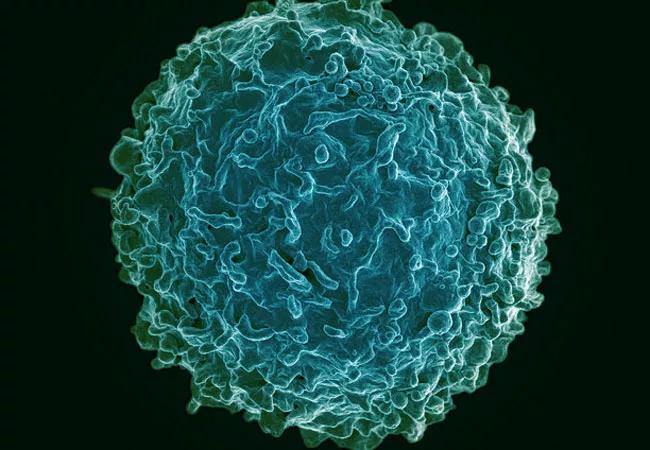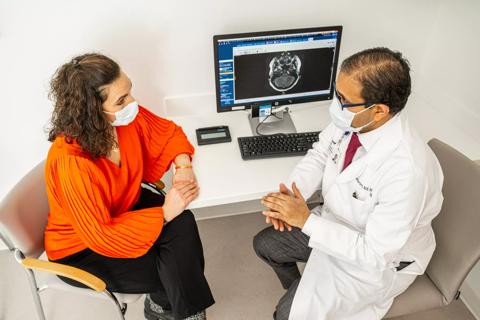Genetics affect how patients respond

Several types of B-cell lymphomas are treated with a regimen known as R-CHOP, which consists of four chemotherapy drugs — cyclophosphamide, doxorubicin, vincristine and prednisone — plus the monoclonal antibody rituximab.
Advertisement
Cleveland Clinic is a non-profit academic medical center. Advertising on our site helps support our mission. We do not endorse non-Cleveland Clinic products or services. Policy
While R-CHOP can be effective overall for patients with diffuse large B-cell lymphoma (DLBCL) and for patients with limited stage (LS) aggressive large B-cell lymphoma (ALBCL), particular subsets of each type do not respond as well to this regimen.
Recently, researchers conducted two separate studies looking at either adding additional agents to the R-CHOP regimen for DLBCL patients or using more intensive immuno-chemotherapy (IIC) in place of R-CHOP for ALBCL patients.
“Often genetic differences among patients with the same disease can have an effect on how certain patients respond to cancer treatments,” says Brian T. Hill, MD, PhD, Director of the lymphoid malignancies program at Cleveland Clinic Cancer Center. Dr. Hill led one study and had a cohort of patients in the other investigation. He presented results of both at the 2018 American Society of Hematology conference.
Dr. Hill designed the study involving patients with DLBCL to test whether novel treatment agents might improve outcomes for a subset of DLBCL patients known as activated B-Cell (ABC) DLBCL patients. (ABC) DLBCL signals through Nuclear Factor-κ-B (NF-κB) and is more likely to display treatment failure than DLBCL arising from the germinal center (GC).
Proteasome inhibitors such as bortezomib disrupt NF-κB signaling; however, randomized trials have failed to demonstrate the clinical benefit of adding bortezomib to R-CHOP for the treatment of non-GC DLBCL. Thus, Dr. Hill is running a phase 1/2 trial using the protease inhibitor carfilzomib (Car) — which displays superior clinical activity relative to bortezomib in plasma cell neoplasms — along with R-CHOP.
Advertisement
The phase 1 portion of the study included 24 patients. Fifty-eight percent were stage I-II at diagnosis, 32 percent were stage II-IV and 88 percent had ECOG performance status of 0-1. Twenty-one percent had B symptoms, 54 percent had an increased lactate dehydrogenase (LDH) at diagnosis and 29 percent had > 1 extranodal site. Eligible patients included primary mediastinal lymphoma (N = 1) and DLBCL of GC (N = 9), non-GC (N = 13) and unknown (N = 1).
There were no dose-limiting toxicities. As of June 2018, median follow-up among surviving patients was 16 months. There were three deaths during the study period, two from lymphoma and one from lung cancer. The overall response rate was 92 percent [75 percent complete remission (CR), 17 percent partial remission]. There was no significant difference in CR rates or progression-free survival (PFS) for patients with GC vs. non-GC subtype.
“We found that carfilzomib plus R-CHOP is safe without significant excess cardiac effects,” says Dr. Hill. The Phase 2 study is open to accrual at Cleveland Clinic, Cleveland Clinic Florida and other sites.
For the ALBCL multicenter study, investigators studied outcomes of patients with high-risk subtypes that harbor MYC rearrangement (MYC-R) with or without BCL2 (BCL2-R) and/or BCL6 (BCL6-R) rearrangements — referred to as double-hit lymphoma (DHL). They hoped to discover whether the poorer outcomes for this group when using R-CHOP alone — which had led to the use of the more aggressive immuno-chemotherapy — held true for early stage patients.
Advertisement
The investigators examined clinical details from 105 patients. Fourteen percent had stage 1, 32 percent had stage 1E, 26 percent had stage 2E, 17 percent had bulky, 58 percent had extranodal, 15 percent had transformed disease and 40 percent had elevated LDH. The majority, 70 percent, had GC B-cell phenotype. Eighty-two had data on BCL2-R and BCL6-R, of which 41 were DHL and four were triple-hit lymphoma.
Forty-five patients received R-CHOP, of which 56 percent had involved field radiation therapy, IFRT. Sixty patients received IIC, of which 42 percent had IFRT.
The overall response rate was 90 percent. Patients with DHL were less likely to achieve CR, compared with patients with MYC-R only (73 percent versus 98 percent). CR rate was higher in the IFRT versus no-IFRT group (92 percent versus 75 percent). In the 27 who had relapsed/refractory disease, distant relapses were more common in the IFRT versus no-IFRT group (87 percent versus 33 percent).
During the median follow-up of 3.2 years, 35 patients progressed or died. Of the 23 deaths, 15 were due to progressive lymphoma, one was due to treatment-related toxicity and seven were due to unrelated causes. Two-year PFS and overall survival were 78 percent and 86 percent for the entire cohort and 72 percent and 82 percent respectively for DHL patients.
“If you just have limited stage aggressive B-cell lymphoma, or stage II in two sites in close proximity, it’s not clear that more intensive chemotherapy is beneficial,” says Dr. Hill. “This analysis demonstrates that intensive immuno-chemotherapy for limited stage MYC rearrangement does not improve progression-free survival, and that also applies to cases with double or triple hit.”
Advertisement
Image credit: Human B Lymphocyte by NIAID(CC by 2.0).
Advertisement
Advertisement

Study measures real-world outcomes for relapsed or refractory large B-cell lymphoma

Optimized responses in transplant- and CAR T-cell therapy-eligible patients

Findings from large database important to inform clinical practice

Socioeconomic disparities have a notable influence on access to allogeneic hematopoietic cell transplant

Offers a new option for patients 60 and older with relapsed/refractory disease

What’s coming up at ASH and beyond

Blinatumomab plus chemotherapy improves overall survival and relapse-free survival over chemotherapy alone

First-ever U.S. population-level retrospective analysis reveals many patients with systemic mastocytosis need faster intervention